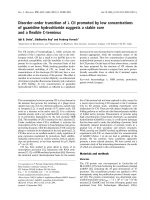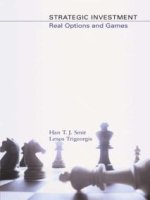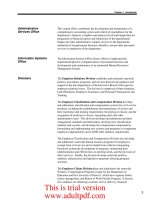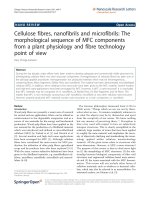Optimal timing of real estate development a real options and game theoretical framework
Bạn đang xem bản rút gọn của tài liệu. Xem và tải ngay bản đầy đủ của tài liệu tại đây (741.79 KB, 144 trang )
OPTIMAL TIMING OF REAL ESTATE DEVELOPMENT
---- A REAL OPTIONS AND GAME THEORETICAL FRAMEWORK
CHU YONGQIANG
(B.S. Beijing University)
A THESIS SUBMITTED FOR THE DEGREE OF
MASTER OF SCIENCE (ESTATE MANAGEMEMENT)
DEPARTMENT OF REAL ESTATE
NATIONAL UNIVERISITY OF SINGAPORE
2004
ACKNOWLEDGEMENT
The author would like to express his gratitude to the following people, who made
the completion of the thesis possible:
Associate Professor Sing Tien Foo, My supervisor, for his invaluable guidance
and advice throughout the whole process of my research in National University of
Singapore. His kindness and gentle personality also impressed me during the past
two years. It is my great fortune to be his student.
My wife, Ning Weiyi, for her love, support, encouragement and forgiveness.
Sorry, honey, I may not be able to accompany you for the next three years.
My parents, my sister, and my lovely niece, for their constant encouragement and
love. I owe a lot to my parents, especially my father, who passed away when I
was writing this thesis. Forgive me, father, and rest in peace.
Lastly to all my friends, who have helped me in one way or another during this
research.
Chapter 1: Introduction .................................................................................................................1
1.1Background ..........................................................................................................................1
1. 1.1 NPV vs. Real Options .............................................................................................1
1.1.2 Market Structure: Competitive Monopoly or Oligopoly? ........................................3
1.1.3 Symmetric or Asymmetric Investors........................................................................4
1.1.4 Complete Information vs Incomplete Information...................................................5
1.2 Motivation...........................................................................................................................5
1.3 Research Questions .............................................................................................................7
1.4 Research Methodology and Framework .............................................................................7
1.4.1 Option Pricing Theory..............................................................................................7
1.4.2 Game Theory............................................................................................................8
1.5 Organization........................................................................................................................9
1.5.1 Literature Review.....................................................................................................9
1.5.2 Basic Real Estate Investment Model......................................................................10
1.5.3 Monopoly Real Estate Investment Model ..............................................................10
1.5.4 Real Estate Investment Model in a Symmetric Duopoly Framework ....................11
1.5.5 Real Estate Investment Model in an Asymmetric Duopoly Framework ................11
1.5.6 Duopoly Real Estate Investment under Incomplete Information ...........................12
1.5.7 Conclusion .............................................................................................................12
Chapter 2 Literature Review .......................................................................................................13
2.1 Option Pricing Theory.......................................................................................................13
2.2 One Developer Real Options Theory ................................................................................17
2.3 Game Theory.....................................................................................................................25
2.4 Real Options under Competition (Option Games) ............................................................28
Chapter 3 One Firm Model Facing Exogenous Rental Flow ....................................................37
3.1 Model Assumptions...........................................................................................................37
3.2 The Model .........................................................................................................................38
3.3 Neoclassical Cases ............................................................................................................41
3.4 Numerical Example...........................................................................................................41
3.4.1 The Optimal Timing ...............................................................................................42
3.3.2 The Developer Value..............................................................................................44
3.5 Conclusion ........................................................................................................................45
Chapter 4 Monopoly Real Estate Developer Model...................................................................46
4.1 Introduction.......................................................................................................................46
4.2 Problem Specification .......................................................................................................49
4.3 The Model .........................................................................................................................51
4.4 Numerical Results and Comparative Static Analysis ........................................................57
4.4.1. The Volatility Effect ..............................................................................................58
4.4.2. Demand Effect ......................................................................................................61
4.4.3. Other Effects .........................................................................................................63
4.5 Conclusion ........................................................................................................................64
Chapter 5 Optimal Timing of Real Estate Development under Symmetric Duopoly .............67
5.1 Introduction.......................................................................................................................67
5.2 Problem Specification and Model Assumptions ...............................................................68
i
5.3 The Developers’ Value ......................................................................................................70
5.3.1 The Follower’s Value .............................................................................................70
5.3.2 The Leader’s Value.................................................................................................72
5.4 The Equilibrium Exercise Strategies.................................................................................73
5.4.1 Y0 < YL .................................................................................................................73
5.4.2 YL < Y0 < YF .......................................................................................................74
5.4.3 Y0 ≥ YF ................................................................................................................74
5.5 Conclusion ........................................................................................................................76
Chapter 6 Optimal Timing of Real Estate Development under Asymmetric Duopoly ...........78
6.1 Introduction.......................................................................................................................78
6.2 Model Specification ..........................................................................................................79
6.3 The Option Values of the Leader and The follower ..........................................................82
6.4 The Equilibrium Exercise Strategies.................................................................................91
6.4.1. Equilibrium Strategy when
α1 ∈ [α1* , +∞) .........................................................91
6.4.2 Equilibrium strategy when
α1 ∈ (α 2 , α1* ) ...........................................................95
Chapter 7 Real Estate Development under Incomplete Information.......................................99
7.1 Introduction.......................................................................................................................99
7.2 Model Specification ........................................................................................................101
7.3 Equilibrium Strategies under Incomplete Information....................................................103
7.4 Conclusion ......................................................................................................................117
Chapter 8 Conclusion and Summaries......................................................................................124
8.1 Contributions...................................................................................................................124
8.2 Limitations ......................................................................................................................126
8.3 Further Directions ...........................................................................................................126
Bibliography ................................................................................................................................128
ii
Summary
This study is trying to apply the real options theory in real estate development, as
real estate investment is irreversible and heterogeneous. This study extends the
existing literature in the following directions: (i) a monopoly real options model is
proposed to examine the optimal timing and intensity simultaneously; (ii) the
symmetric duopoly model is extended to asymmetric duopoly games; (iii) the
incomplete information is incorporated in examine the asymmetric model…
The Monopolistic model shows that the uncertain exogenous economic shock and
the demand factors contribute to the option value of real estate development. In the
asymmetric model, the sub-game perfect Nash equilibrium is derived under different
levels of comparative advantage for two different developers. In the incomplete
information model, a set of Bayesian Nash equilibrium is derived based on the
results obtained in asymmetric duopoly model.
i
List of Tables
3-1 The Basic Values of Relevant Variables……………………………………..42
4-1 Input Assumptions for Numerical Analyses ………………………………...58
4-2 Comparative Statics ………………………………………………………….64
7-1 Equilibrium Strategies ( ξ > ξ * , α1 = θξ , α 2 = θξ )…………………………..119
7-2 Equilibrium Strategies ( ξ > ξ * , α1 = θξ , α 2 = θ / ξ )………………………..120
7-3 Equilibrium Strategies ( ξ > ξ * , α1 = θ / ξ , α 2 = θ / ξ )……………………...120
7-4 Equilibrium Strategies ( ξ < ξ ** , α1 = θξ , α 2 = θ / ξ ) ………………….…121
7-5 Equilibrium Strategies ( ξ < ξ ** , α1 = θξ , α 2 = θξ )………………………...122
7-6 Equilibrium Strategies ( ξ < ξ ** , α1 = θ / ξ α 2 = θ / ξ )……………………..123
ii
List of Figures
3-1 Trigger Value as a Function of Uncertainty……………………………….43
3-2 Developer Value as a Function of Rental Flow…………………………….44
4-1 Value Function of the Developer…………………………………………...54
4-2 Volatility Effect on Option Trigger Value…………………………………...58
4-3 Volatility Effect on Optimal Intensity……………………………………….59
4-4 Value of the Development Option …………………………………………..60
4-5 Effects of Rental Sensitivity of Demand on Optimal Timing ……………….62
4-6: Optimal Intensity of Different Price Sensitivity of Demand……………...…63
4-7: Development Option Value………………………………………………….64
6-1 Developer 1’s Value…………………………………………………………..87
6-2 Developer 2’s Value When α1 > α1* > α 2 ……………………………………….89
6-3 Developer 2’s Value When α 1 * > α 1 > α 2 ………………………………..90
iii
Chapter 1: Introduction
1.1Background
1. 1.1 NPV vs. Real Options
In the neoclassical economics, investment is an act of incurring an immediate
cost in anticipation of future rewards. Real estate investment is one of the most
important categories of asset class of investment. Investment is risky and no
one can guarantee how much the rewards will be over a fixed holding period.
There is always uncertainty over the future market condition at the time when
an investment decision is made. How should an investor, facing uncertainty
over future rewards, decide whether to invest or not. The neoclassical economic
theory offers a standard approach to evaluate the feasibility of an investment:
First, investor should calculate the present value of the expected stream of
profits that the investment project will generate. Second, they should calculate
the present value of the expected expenditure required for the investment.
Finally, they determine whether the difference between the two, which is
known as Net Present Value (NPV), is greater than 0. If the answer is yes, it is
feasible to invest in the project.
Although the NPV rule has been used widely, some of the underlying
assumptions appear to be unrealistic. It is myopic to assume that an investment
is reversible. It implies that a wrong investment decision can be undone and the
1
investment costs can be recovered should the market conditions turn out to be
worse than expected. The reversible investment decision is a now or never
decision, that is, either the investor invests now or never invests. These
conditions may hold for some investment, they are, however, not satisfied in
most investment decisions. In real estate investment, irreversibility and the
possibility of delaying an investment decision are important characteristics. The
recent development of the option pricing theory greatly challenges the
propositions of neoclassical investment models. An investment opportunity is
regarded as an option---- an investor has a right but not an obligation to buy an
asset (which is referred to, in this context, a finished project that will generate
future cash flow) at some future time. When an investor makes an irreversible
investment, it kills the option of waiting to invest. The option to invest, like a
financial call option, does have value. Thus the exercise of the option is
equivalent to giving up the option to wait for possible increase in the value of
an underlying asset, which can be viewed as opportunity cost foregone, which
must be included as part of the investment cost. Taking into consideration of
this option value, the NPV rule must be modified as: invest when the present
value of the expected stream of future income is at least as large as the present
value of the expected expenditure plus the opportunity cost, that is, the value of
option of waiting to invest.
In Trigeorgis (1996b), the new investment rule is
defined based on the new concept of expanded net present value, that is:
Expanded net present value=standard (static) net present value of expected cash
2
flows +option premium.
Studies have shown that the opportunity cost of investing can be significant,
and ignoring it can be erroneous. Like the financial option, this opportunity
cost is highly sensitive to uncertainty of the future cash flow. To differentiate
this investment from the standard options on financial asset, a new term, real
option is used in the literature. The study aims to use real options theory to
analyze real estate investment, especially the timing problems in real estate
development.
1.1.2
Market
Structure:
Competitive
Monopoly
or
Oligopoly?
In traditional real options model, the market structure is not clearly defined.
Although most of the literature assumes that there exists only one firm in a
market, in the literature the investment payoff, which always follows a
geometric Brownian motion, is assumed to be exogenously determined. The
firm under this framework, is, therefore modeled as a price-taker, which is a
key characteristic of competitive market. But the market structure is not
explicitly stated in most of the existing literatures, they model the only firm in
the market, and assume it as a price taker, which may be misleading as if there
is only firm in the market, and thus the market cannot be competitive.
In this study, I analyze real estate investment options that are modeled within
clearly defined market structure, either in a monopoly market or in an oligopoly
3
market. In the oligopoly model, I put real estate investment problem in both
real options and the game theoretical methodology. As it is commonly accepted
that real estate market are not a competitive market due to the special
characteristics of real estate (i.e. the product is heterogeneous); therefore real
estate investment behavior will not be appropriate to be examined in a
competitive market setting1.
1.1.3 Symmetric or Asymmetric Investors
To model the investment behavior in an oligopoly market, I assume that there
are few investors who have equal access to the investment opportunities. There
are different characteristics associated with the investors; Symmetric investor
framework is a simple building block of the model, in which all investors are
identical. The advantage of the framework is that I can expect the equilibrium
strategies also to be symmetric, I can simply solve for symmetric strategies in
the model. A natural extension to this is to model asymmetric investors, which
is more realistic. In the asymmetric oligopoly model, one investor may have
comparative advantage over other investors. The comparative advantage can
take different forms, for example, cost asymmetry, price asymmetry, etc. In real
estate market, the comparative advantage is more of location specific.
This study will focus on the asymmetric duopoly real option games developed
upon the symmetric game framework in the previous literature.
1
It may be, however, more appropriate to model it as monopolistic competition in well developed real estate
market, while in the Asian context, it is more appropriate to model it as oligopolistic market
4
1.1.4 Complete Information vs Incomplete Information
In studying oligopoly market in the real options and game theoretical
framework, information completeness is very important. Is the information
complete or incomplete? If it is complete, how the general Nash equilibrium
can be derived. If not, what kind of information is not known or is private?
How the private information is revealed in the option games, and how the
Bayesian Nash equilibrium can be obtained based on incomplete information?
These are questions to be answered in this study. Both complete information
models and incomplete information models will be developed in this study.
Although the scenarios in incomplete information models are much more
complex, the equilibrium strategies are still tractable based on the results from
the complete information models.
1.2 Motivation
The option pricing theory, since the seminal paper by Black and Scholes (1973),
stimulated the growing literature on real options. Real options has become a
very important parts of the finance research, especially in the corporate finance
research. Researches have been expanded rapidly in various industries, such as
natural resources, R&D and others. The importance of real options theory has
also gained attentions by many companies and interesting applications of real
option models have been developed.
Real estate investment is very suitable to be analyzed using the real options
5
theory. Real estate investment is obviously irreversible, or at least partially
irreversible. Real estate market is also full of uncertainties because of the
irregularities in real estate cycles.
Compared to other types of investment, real estate investment has some special
characteristics. Firstly, real estate is heterogeneous due to its spatial
characteristics. The heterogeneity of real estate investment means that no two
real estate projects are identical. Secondly, real estate development process is
complex and it takes relatively long time to complete. The so called
time-to-build feature cannot be ignored in real options analysis, especially
when the focus is on timing games. Thirdly, real estate markets are subject to
real estate cycles, which may be different from the common business cycles.
Thus it is challenging to use real estate as a subject of this research and I hope
real option theory can explain different investment behavior in the market and
help better understanding of real estate markets, especially real estate cycles.
The real options literatures have been growing very fast. There are, however,
still some important questions yet to be addressed, especially the questions
concerning option games. The underlying theory of stochastic continuous time
game is still not well developed. This study hopes to contribute to filling the
theoretical gap in real options research in a small way by using new
methodology in real options and game theory.
6
1.3 Research Questions
The basic question this study attempts to answer is: When is the optimal time
for developer(s) to start real estate development?
This question will be further
expanded based on different assumptions concerning the market structure and
the information completeness. The sub-questions, all of which will be answered
in a separate yet consistent framework, include:
(1) In the monopoly real estate development market, what is optimal timing
and density of development?
(2) In an asymmetric duopoly real estate market, is there an equilibrium
strategy for both developers in choosing their optimal timing?
(3) If the comparative advantages of developers are private information, what
is the equilibrium strategy and how the equilibrium strategies will be
different compared with the case in complete information?
1.4 Research Methodology and Framework
The option pricing theory (Black & Scholes, 1973) and the game theory are
two main techniques used in this research.
1.4.1 Option Pricing Theory
In general, there are two approaches of pricing options. The first one is the
arbitrage method, in which dynamic risk free portfolio consisting of options
7
and underlying assets is made. In the arbitrage free market this dynamic risk
free portfolio earns a risk free interest rate over a fixed interval. Following this
argument, a partial differential equation can be derived. The second method is
the martingale method or the risk neutral valuation, in which the option is
priced as the expected future payoffs using the equivalent martingale measure.
In this paper, the risk neutral valuation is used because of the following two
reasons: (i) it is very difficult to form an arbitrage free portfolio of real estate,
as the asset is illiquid and not completely tradable; (ii) we assume that the risk
faced by individual developer is firm specific or industry specific risk.
According to CAPM, there is no risk premium associated with diversifiable
risk.
1.4.2 Game Theory
The option-game approach examined in this study is different from the classical
game theoretical framework. It is neither a standard form game nor extensive
form games. In the stochastic game, the sequence of movement itself is
endogenous, rather than exogenous as in the extensive form games. In the
complete information game, the equilibrium strategy is the Markov Sub-game
perfect Nash equilibrium, and the equilibrium in incomplete information game
is the Markov sub-game perfect Bayesian Nash equilibrium.
8
1.5 Organization
The rest of this chapter outlines the plan of the study and gives a brief
introduction to the basic ideas and results of the models.
1.5.1 Literature Review
Chapter 2 surveys on related literature in this field. The literature consists of
four main parts. The first part surveys the general option pricing literature,
which traces as far back to the classical option pricing theory by Black &
Scholes (1973) and Merton (1973). Some pricing methods developed by these
pioneering researchers will be introduced in this part. The second part of the
literature review real options model with a single firm; this part will generally
follow Dixit & Pindyck (1994), Trigeorgis (1996b) and Pindyck (1991). And
also some of the recent development since Trigeorgis (1996b) will also be
introduced in this part. The third part of this review will be on game theory.
Given the vast volume of game theory literature, it is impossible to do a
complete survey on game theory literature, some classical game theory
literature and selected stochastic continuous time game models will be
discussed. The fourth part of this review is devoted to recent development in
the real option games literature. This stream of literature forms the basic
building block for the proposed models in the study; more detailed discussion
will be included to highlight the difference between the existing literature and
those proposed in this study.
9
1.5.2 Basic Real Estate Investment Model
Chapter 3 introduces the basic model on the optimal timing of real estate
investment. In this basic framework there is only one real estate developer with
uncontested access to the real estate investment opportunity and at the same
time the value of the finished project is exogenously determined. Although the
timing problem is the main focus of this study, in this chapter, the
characteristics of the project value are also emphasized to show the importance
of the option premium as contrast to the traditional NPV rule. Numerical
analysis will be conducted to examine the sensitivity of different controlled
variables on the timing option premiums.
1.5.3 Monopoly Real Estate Investment Model
Chapter 4 introduces a monopoly real estate investment model, where there is
only one real estate developer in the market that is access to the investment
opportunity. The rent generated from the finished project is assumed to be
endogenous in the model. The developer can choose its optimal timing and
optimal intensity at the same time. Besides analytical solutions to the optimal
timing and optimal intensity decisions, numerical analyses will also be carried
out to compare the results with those obtained in Chapter 3. Besides the market
uncertainty, the demand function is expected to have significant impact on the
optimal timing decision.
10
1.5.4 Real Estate Investment Model in a Symmetric
Duopoly Framework
Chapter 5 is on the symmetric real estate investment model which is first
generalized by Grenadier (1996a). It forms the base of asymmetric duopoly and
incomplete information models. The main results of the symmetric model and
Grenadier’s model will be discussed, in conjunction with possible extensions of
the models and to discuss how the model can be extended.
1.5.5 Real Estate Investment Model in an Asymmetric
Duopoly Framework
Chapter 6 elaborates the asymmetric duopoly model; which is extended from
Grenadier’s (1996a) model by allowing asymmetric investor and asymmetric
equilibrium strategy. One developer is assumed to have comparative
advantages over the other by assuming that they have deterministically
different inverse demand functions. The results show that different levels of
asymmetry or different levels of comparative advantage will result in different
equilibrium strategy. If the difference in comparative strength is large, the
superior developer faces no preemptive competition from the other developer.
It can choose its own optimal timing regardless of other’s strategy. While if the
difference in comparative advantage is small, the superior developer will face
preemptive competition in some cases.
11
1.5.6 Duopoly Real Estate Investment under Incomplete
Information
Chapter 7 extends the asymmetric duopoly model elaborated in chapter 6 by
further relaxing the assumption of complete information. For each developer,
he only knows his own information, but not the others. He knows only the
information of the distribution of demand function parameters. For simplicity,
the distribution used in this chapter is a binary distribution as adopted by
Grenadier (2000). The Bayesian Nash equilibrium strategies under different
scenarios are derived and the differences between complete information and
incomplete information models are examined. The results show that in some
cases, incomplete information causes welfare loss in the sense that the
developer will choose the timing that is not optimal if the information is
complete.
1.5.7 Conclusion
Chapter 8 concludes the study by discussing the main results form the models
and also the limitations of the study. The directions for further research will
also be presented in this chapter.
12
Chapter 2 Literature Review
The literature on real options and game theory are two important sets of works
that are reviewed in this chapter. The literatures are divided into four parts. The
first part of the literatures is the option pricing theory, which forms the
methodological foundation of real options. The second part is about the
literature of real options model with only one firm in the market. The third part
focuses on game theory, especially the literature on stochastic game models.
The last part is about the option games. Both competitive market option game
models and oligopoly market option game models are included.
2.1 Option
Pricing Theory
The development of real option is partly stimulated by the breakthrough of
research in the option pricing theory. Since the early 1970s, the option pricing
problem has become an important part of the modern finance research. Given
the large volume of the option pricing theory literature, it is impossible to
survey all the literatures on option pricing theory. The most representative
literature in option pricing theory is reviewed in this section.
The breakthrough in the option pricing theory is initiated by Black and Scholes
(1973) 1 . In their seminal paper “The Pricing of Options and Corporate
Liabilities”, they proposed an arbitrage framework for pricing financial options,
1
Although there are several papers on option and warranty pricing prior to Black and Scholes (1973), their results
are almost unsatisfactory of incomplete. Among them are Boness (1964) and Samuelson (1965) and Samuelson
and Merton (1969). The review of the early literature can be found in Smith (1976).
13
taking into account the following assumptions:
(1) The short term interest rate is known and constant
(2) The stock price follows geometric Brownian motion.
(3) The stock pays no dividend
(4) There are no transaction costs in buying or selling the stock or the option.
(5) No restriction on borrowing at the short term interest rate.
(6) No penalty for short selling
Based on these above assumptions, they created a dynamic risk free portfolio
made up of the underlying stock and the option. This risk-free portfolio is
expected to earn the risk free interest rate over a short interval. Then, they
derived the famous Black-Scholes equation1:
1 2 2 ∂ 2C
∂C ∂C
σ S
+ rS
+
− rC = 0
2
2
∂S
∂S ∂t
(2.1.1)
C ---- The Option Value
S ---- The Stock Price
C ---- The Stock Price Volatility
r ---- Short Term Risk Free Interest Rate
The Black and Scholes equation is the cornerstone of option pricing theory,
although the equation forms may vary with different assumptions. The real
option pricing equation can also be derived using the same methodology.
1 1
To keep a consistent style of notation and to be consistent with the majority of the literature, the notation used
here is different from that of Black and Scholes (1973).
14
However in real options model, there is normally no time limit on the
expiration of the option, therefore the time dimension of the stochastic process
is normally dropped in the real options model.
In the same year, Merton published his paper “Theory of Rational Option
Pricing”, in which, he firstly derived several restrictions on rational option
pricing using the arbitrage argument. It also extends Black and Scholes
derivation of option pricing formula by using more rigorous procedure with
different assumptions, which include:
(1) Frictionless markets: There are no transaction costs and differential taxes,
trading takes place continuously; and short selling is allowed without
restriction.
(2) Stock price dynamics: the stock price follows a geometric Brownian
motion.
(3) Bond Price Dynamics: the bond price follows a general ito’s process
(4) No assumptions are necessary for investors’ preferences.
Other major contributions of this paper are the inclusion of dividend payout in
the option pricing formula, and also the closed form valuation of American put
option. This paper puts option pricing in a more general framework and uses
more rigorous mathematical derivation to enrich the theoretical strength of the
option pricing theory.
Although the publication of the two papers has brought the field to almost
15
immediate closure on the option-pricing theory1, the refinement of the theory is
still a major agenda in the finance literature today. Some of the significant
developments are discussed below.
Cox and Ross (1976) introduce a new technique in deriving the Black-Scholes
equation. Based on the forward (Fokker-Planck) equation and Kolomogorov
Equation, a new technique to value the options when the stock follows some
alternative jump diffusion processes is proposed.
The second paper along this line of research is by Cox, Ross and Rubinstein
(1979). In their paper, they propose a simple option pricing approach by
assuming that the stock price follows a binary process, they also show that
taking the limit of the option price obtained in this way yields the
Black-Scholes formula. This method, called the binomial tree method, has been
developed to one of the three main numerical methods in solving the option
pricing problems.2 Many real options literature also use binomial tree model
rather than use the continuous time model in dealing with respective option
problems.3 Merton (1976) in another important paper relaxing the assumption
with respect to continuous stock return, which follows a discontinuous process,
which pose some problems in replication strategy. The derived formula retains
most of the features of the original Black-Scholes formula; it does not depend
on investors’ preference or knowledge of the expected return on the underlying
1
2
3
See Merton (1998)
The other two numerical methods are finite differences and Monte Carlo simulation.
For example, Titman(1985), Trigeorgis (1996a) Trigeorgis (1996b)
16
stock. The work by Ingersoll(1976), which modifies the option pricing model
to account for the effect of differential tax rates on capital gains versus ordinary
income, is also an important improvement of the Black-Scholes model.
2.2 One Developer Real Options Theory
The option pricing theory has significant influence on investment theory, via
the development of the real options theory.
An irreversible investment opportunity is like a financial call option, which
gives the holder the right to pay an exercise price, and receive an asset that has
some value in return. The only difference between financial option and real
options is that the exercise of real options has no time constraints. Thus, in real
options the important issue is to determine when to exercise the option, i.e.
when is the optimal timing of investment when future payoff is uncertain.
The optimal timing problem of investment in an uncertain environment was
first examined in the seminal paper of McDonald and Siegel (1986), in which
they propose a simple continuous timing framework to solve the optimal timing
problem.
In the basic problem proposed in McDonald and Siegel (1986)1: the firm can
pay I t to install an investment project at any time t . The expected future net
cash flows conditional on undertaking the project have a present value X t ,
1
In order to keep the consistency of the notation of the whole thesis, the notation used here is different from
McDonald & Siegel (1986).
17
which is assumed to follow a geometric Brownian motion:
dX t = α x X t dt + σ x X t dwx …………………………………………….. (2.2.1)
Where wx is the standard wiener process.
Similarly I t is assumed to follow another geometric Brownian motion1:
dI t = α i I t dt + σ i I t dwi ………………………………………………. (2.2.2)
The relationship between these two stochastic processes is described by a
correlation coefficient:
E (dwx dwi ) = ρ dt ………………………………………………………. (2.2.3)
Using the contingent claim valuation 2 , the following partial differential
equation (PDE) is derived:
0.5(σ x2 X 2VXX + 2 ρσ xσ i XIVXI + σ i2 I 2VII ) + (r − δ x ) XVX + ( r − δ i ) IVI − rV = 0
………… (2.2.4)
where δ x and δ i are known as the “convenience yield” or the “rate-of-return
shortfall” in X and I respectively, which can be calculated from simple
CAPM.3
By transforming the PDE to ordinary differential equation (ODE) and subject
the ODE to a set of boundary conditions, an analytical solution can be obtained
from the ODE. The results show that there is a trigger value given as ratio of
X over I , at which if the ratio first reaches or exceeds the trigger value,
1
As shown in McDonald &Siegel (1986), to allow the cost evolve stochastically do not make big difference in the
analysis of timing analysis and also the mathematical treatment, in the models developed in this thesis, I will
assume the cost to be constant.
2
The contingent claim valuation methodology requires that the risk associated with X and I is spanned by the
market assets
3
See Dixit and Pindyck (1996), 115-116.
18









